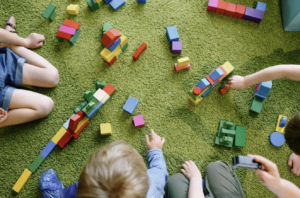How does problem solving develop through play?
Kids have a drive to play! Through play they learn about the world around them, explore ideas, learn how things work and test their ideas.
In this joint blog, Speech Pathologist Marion Giddy & Occupational Therapist Renee discuss how both ‘Executive Functioning’ Skills and ‘Language Skills’ intersect with a child’s play – to help parents and educators notice & shape that developed through modelling and interaction!
So let’s start by sharing some of the vocabulary..
What is executive functioning?
Executive functioning is a set of mental skills that help children manage their thoughts, actions, and emotions (Best & Miller, 2010).
Executive skills help us to: 
- Initiate – get started on a task or instruction
- Inhibit – inhibit impulse actions, thoughts or behaviours at the appropriate time
- Shift – ability to move between activities and tasks smoothly
- Emotional Control – our ability to monitor and regulate our emotions and emotional responses
- Working Memory – hold information in our mind and use it in what we do e.g. remembering 3 directions and carrying all three out
- Plan – plan what we need to do to get a task finished
- Organise Materials – organise our belongings to that we can find them and use them consistently
- Self-Monitor – monitor our behaviours and actions in relation to others
- Task-Monitor – monitor what we are doing in a task to ensure we follow through on our plan and complete it the way we need to
Well-developed executive skills is like ‘having an air traffic control system at a busy airport to manage the arrivals and departures of dozens of planes on multiple runways’ (Center on the Developing Child, Harvard University, 2021).
Just like the traffic controller keeps track of multiple planes and cues them in, executive functioning helps children organise their thoughts, control impulses, and manage tasks to stay on track. Without it, things can quickly become a bit messy.
We want children to have a strong grasp on their executive skills so that when a problem arises, they feel confident in knowing what they can do, think, or say to solve it.
What language skills are we referring to?
In this blog, we will focus our attention on the development of ‘inferencing skills’. Here’s a few relevant quotes from the literature.
Why is this so important? – because it’s easy to overlook!
“Language is so readily acquired and so universal in human affairs that it is easy to forget what a complex phenomenon it is.” (Bishop, 2014b, p. 1)
Why is inference needed? – to get the ‘gist’.
Adequate inferential comprehension is particularly important during discourse- level communication in order to understand the coherent whole, or ‘gist’, of the discourse (Bishop, 2014b).
Why is inference needed? – because we use it everyday!
Inferential comprehension is a hidden, but critical, skill in everyday communication – inferences are usually drawn automatically to facilitate comprehension and allow the individual to participate effectively in communication. The significance of inferential comprehension to our everyday communication often only becomes apparent when there is a breakdown in the process. (Dawes, 2017)
What is the goal of inference? – building a ‘mental model’ to compare situations
Effective comprehension also involves a significant contribution from top-down processes, such as using the environmental and social context, prior knowledge and experiences, and integrating information in order to build a mental (or situation) model for understanding of discourse (Bishop, 2014b).
What happens when inferencing breaks down? – impacts on social & learning participation.
Poor inferential comprehension can have a significant impact on a child’s participation in social and learning situations, such as understanding conversations and play with friends, developing vocabulary, and participating in oral and written classroom discourse including narratives – an important bridge to literate language (van Kleeck, 2008).
Inference is essentially the ability to create meaning from individual ideas, and build ‘logical bridges’ or links between those ideas, thus drawing conclusions – as they use this information to form a mental ‘picture’ of a situation or event.

Inferencing is a skill that children begin to learn around the age of three (Why questions emerging), which then continues to develop through to age 5-6 (with prediction, hypothesis), and then is expanded upon as children enter the literate world, continuing to develop through to the adolescent years.
It is the ongoing development of understanding that moves from what the child can directly see & experience (concrete world) – into increasing levels of abstract thinking.
In modelling problem solving language, the aim is to help children receive targeted exposure to and develop comprehension of the types of words & sentences that are involved in the thinking process – that allow children to draw connections between what they see, hear & think – and then → make conclusions.
Some aspects of language that are useful to model explicitly and frequently are:
- Sentence structure – use of complex conjunctions
- Because, when, if, until, otherwise, so,
- Hypothetical questions – how, why & what if!
- How (how did it happen, how should we do it?)
- Why
- What will happen if?
- Building logical ideas – developing inference
- Use other WH questions to narrow down the ideas and to give ‘clues’ (e.g. ‘what can you see, what does that part do? I wonder what else we could use..?).
Skills in these two areas develop alongside each other. Parents and carers can use everyday situations, like routines and play, to target one, or the other.
Strategies to try at home to build executive functioning & inferencing skills!
One: Modelling Think Alouds
This is when a parent or adult talks out loud about what they, or a character might be feeling and thinking during play. Here’s an example:
You’re building a house out of blocks for your child’s dolls but realise you’re missing a roof piece.
In this moment, you could just grab the long block next to you, and make the roof without even bringing attention to it.
Instead, you use this opportunity to talk through your problem solving process. You pause and say, “Hmm, I can’t see any more flat pieces for the roof. What can I do? I could use this long block instead, or maybe build the roof with smaller pieces. What do you think will work?” Then, you make a plan together.
The next time your child is playing, you hear them say, “Hmm, I can’t get this puzzle piece to fit. Maybe I need to try turning it a different way?”
What you have done is given your child a template for how to approach problem-solving and self-talk. They’ve learned how to pause, assess the situation, consider options, and make a plan—just like you modelled.
Over time, this will translate to day-to-day experiences, like when they’re getting dressed and can’t find their favourite shirt, or when they’re trying to figure out how to share toys with a friend. By thinking out loud, they’ll use the same strategy to manage frustration, navigate challenges, and find solutions in everyday life.
Two: Using Questions
Questions & Answers are a natural part of conversation with kids. And of course- they go both ways! Here are some examples of everyday questions you can build into daily routines.
Children naturally go through a stage of language development where they ask why why why over and over → and we can flip this around, leading children through that stage as well. Remember the goal is not to give black & white answers about the world (“because I said so” or “ It just is”) but rather to guide children into finding the answers, and making conclusions for themselves.
When your child is brushing their teeth –
Why are we brushing our teeth? Rather than saying – To make them clean (black and white)
Explore… Well what happens to our teeth when we eat? What gets on them? Can you feel the food still on your teeth? What will happen if we leave the food there? Did you know there’s tiny germs in your mouth that like to eat the food too? What does our tooth brush do? It brushes & scrapes the food off. Why do we rinse? To wash the toothpaste out. Where do the germs go when we rinse, out of our mouth! If the germs stay in our mouth what happens? Our teeth can get holes. What other body parts do we wash clean as well? What would happen if we didn’t clean our bodies? (you get the idea!)
Three: “I wonder”…
Young children often assume parents or teachers have a magical ability to know everything & do everything (!) Flipping this on it’s head, and pretending you don’t know, don’t have the answers, or can’t solve a problem is a great way to play & pretend together – and provide learning opportunities for your child to fill the gap – thus building the ‘logical bridge’.
Wondering like this, and helping kids follow along your train of thought, helps him to create their own associations between ideas, causes & effects. This helps lay a map for that type of thinking, which the child can then use in a different situation.
Modelling ‘I wonder’ could look like pretending something is lost, stuck, or you don’t know how to fix something that is broken. A recent example in a therapy session, a child noticed that a lid to a box had a crack in it.. And showed it to the speech pathologist. We had a 10 minute conversation about..
How did that happen? (did someone push it? Could it have been a hammer?)
How can we fix it? (could we use glue? Why not? What else could we use? Could we use a hammer & nail? Why not? Because it’s plastic)
What will happen if we don’t fix it? (It’s sharp someone might get hurt / the things will fall out of the box)
Etc
In short…
In busy daily life, it’s easy to overlook the opportunities for guiding & teaching – however embedded in day to day life are multiple opportunities to help kids understand more about their world at a deeper level, learn new vocabulary about situations, and create logical links between ideas.
Remember the focus is not necessarily on the content of the questions – but rather the skill of forming logical bridges between ideas, questions & answers.
Everyday life is filled with opportunities to embed learning, guidance and support children in their understanding of the world. If reading about the language side of things has sparked your interest – highly recommend continuing the reading journey with this blog here https://thedldproject.com/inferences/ !
Enjoy trying out these strategies, and reach out to our Speech Pathology or Occupational Therapy team if you would like more support or information about supporting your child to learn to problem solve!
Written by Renee Williams (Occupational Therapist) and Marion Giddy (Speech Pathologist)


